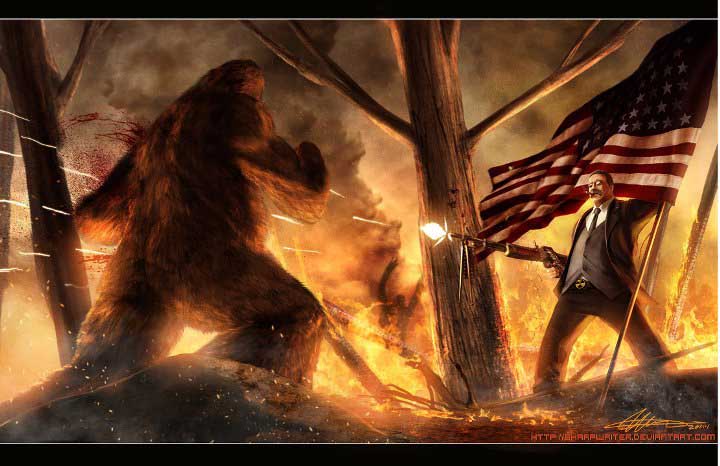
January 14, 2014

From our friends at Who Forted?:
Truth Be Told: Roosevelt’s Wendigo Survivor Identified?
Among the books written by Roosevelt out in remote Montana was The Wilderness Hunter, published in 1893. Tossed in between tales of heroic hunters and tough-as-nails outdoorsmen is one puzzling piece of history that cryptozoologists have latched on to as a second hand account of one man’s encounter with something as-yet unidentified. Roosevelt himself rationalized it as a credible account of something horrific and made no attempt to pass judgment on the man who told him the story, leaving its validity up to readers to decide, but nonetheless documented the precise details in his book:
“But I once listened to a goblin story which rather impressed me. It was told by a grizzled, weather-beaten old mountain hunter, named Bauman, who was born and had passed all his life on the frontier. He must have believed what he said, for he could hardly repress a shudder at certain points of the tale; but he was of German ancestry, and in childhood had doubtless been saturated with all kinds of ghost and goblin lore, so that many fearsome superstitions were latent in his mind; besides, he knew well the stories told by the Indian medicine men in their winter camps, of the snow-walkers, and the spectres, and the formless evil beings that haunt the forest depths, and dog and waylay the lonely wanderer who after nightfall passes through the regions where they lurk; and it may be that when overcome by the horror of the fate that befell his friend, and when oppressed by the awful dread of the unknown, he grew to attribute, both at the time and still more in remembrance, weird and elfin traits to what was merely some abnormally wicked and cunning wild beast; but whether this was so or not, no man can say.
When the event occurred Bauman was still a young man, and was trapping with a partner among the mountains dividing the forks of Salmon from the head of Wisdom River. Not having had much luck he and his partner determined to go up into a particularly wild and lonely pass through which ran a small stream said to contain many Beaver. The pass had an evil reputation, because the year before a solitary hunter who had wandered into it was there slain, seemingly by a wild beast, the half-eaten remains being afterwards found by some mining prospectors who had passed his camp only the night before.”
This particular tale of an attack from an unknown beast, told to Roosevelt by the surviving witness, has been detailed in many books and blogs over the past few decades. For this reason, I’ll spare you too much detail, aside from the fact that Bauman and his friend noticed footprints of a bipedal creature of unknown origin. They believed it was hunting them, and it ravaged their campsite on two separate occasions. They saw its footprints—being hunters by trade, they could distinguish prints left my something on four legs compared to two—and even heard what was described as “a harsh, grating, long-drawn moan, a peculiarly sinister sound” coming from the nearby woods. The creature has been tied in with Bigfoot reports for many years, but the description given to Roosevelt of his friend’s body after the attack doesn’t sound quite like any Sasquatch you might be familiar with:
“…At first, Bauman could see nobody; nor did he receive an answer to his call. Stepping forward he again shouted; and as he did so, his eye fell on the body of his friend, stretched beside the trunk of a great fallen spruce. Rushing towards it, the horrified trapper found that the body was still warm, but that the neck was broken, while there were four great fang marks in the throat.”
Some think it might be a Wendigo: a human-turned-cannibalistic creature of native lore. Or could it be a werewolfsquatch, wolfman, or dogman? Whatever its identity, little more is known about the encounter than the slight details mentioned in Roosevelt’s book. Given the rivers mentioned, we can give the encounter an approximate location: in the southern Bitterroot Mountains in the Beaverhead Mountain Range separating the Salmon River from the Big Hole River (once called the Wisdom River) on the border of Montana and Idaho.
The bigger question is who was Bauman? There’s very little information to go on, aside from his German heritage, being a trapper and frontiersman, and being older than Roosevelt. Yet quite surprisingly, there might be a match in historical records. Born in Germany in 1831, Carl L. Bauman was an early pioneer who came to live in Montana around the 1860s. That means he would have lived in Montana at the same time Roosevelt began visiting the state and would have been in his 50s at the time. The only other recorded information about Carl Bauman is that he passed away on March 20, 1909 near Melrose, Montana.
Read the rest of the story at Who Forted?
About Craig Woolheater
Co-founder of Cryptomundo in 2005.
I have appeared in or contributed to the following TV programs, documentaries and films:
OLN's Mysterious Encounters: "Caddo Critter", Southern Fried Bigfoot, Travel Channel's Weird Travels: "Bigfoot", History Channel's MonsterQuest: "Swamp Stalker", The Wild Man of the Navidad, Destination America's Monsters and Mysteries in America: Texas Terror - Lake Worth Monster, Animal Planet's Finding Bigfoot: Return to Boggy Creek and Beast of the Bayou.
Filed under Bigfoot, Bigfoot Report, Books, Cryptozoology, Folklore, Pop Culture, Sasquatch